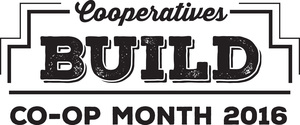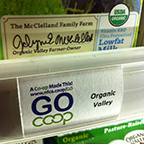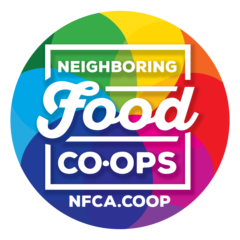 This October, the Neighboring Food Co-op Association (NFCA) is joining over 30,000 co-ops and credit unions across the United States in celebrating Co-op Month, recognizing the many ways co-operatives help to build stronger communities and more resilient local economies. For 2016, the National Cooperative Business Association CLUSA International (NCBA CLUSA) has identified “Co-operatives Build” as the theme, spotlighting the advantages co-ops offer to their members and the communities in which they live and work. For ideas and resources to help your food co-op join the celebration, see below.
This October, the Neighboring Food Co-op Association (NFCA) is joining over 30,000 co-ops and credit unions across the United States in celebrating Co-op Month, recognizing the many ways co-operatives help to build stronger communities and more resilient local economies. For 2016, the National Cooperative Business Association CLUSA International (NCBA CLUSA) has identified “Co-operatives Build” as the theme, spotlighting the advantages co-ops offer to their members and the communities in which they live and work. For ideas and resources to help your food co-op join the celebration, see below.
“Across New England, food co-ops help people build community,” said Erbin Crowell, Executive Director of the NFCA. “For example, the majority of our member co-ops have been in business for over 30 years, providing healthy food, jobs and a market for local producers for decades.”
The NFCA includes more than 35 food co-ops and start-up initiatives, locally owned by more than 107,000 people. Together, these co-ops employ over 1,800 people, generate revenues of more than $250 million, and purchase more than $50 million from local producers each year. In recent years, a new wave of community based start-up initiatives has been working to open new food co-ops in communities across our region. (For a map of member co-ops, visit www.nfca.coop/members.)
Co-operatives are businesses that are owned and governed by their members, the people who use the products and services they provide. From food co-ops to farmer co-ops, worker co-ops to credit unions, and housing co-ops to energy co-ops, co-operatives make a difference in people’s lives every day. Co-ops are also more common than you might think: Here in the United States, 1 in 3 people are members of at least one co-op or credit union. Nationwide, co-operatives create 2.1 million jobs and generate more than $650 billion in sales and other revenue annually.
 Learning more about some of the co-operatives in our food system is easy: Just look for the “Go Co-op” signs on the shelves of your Neighboring Food Co-ops. You may be surprised to find so many items made by co-operatives in New England, including dairy products from Cabot, McCadam and Organic Valley, fresh produce from Deep Root Organic Co-op, fairly traded coffee, tea and chocolate from Equal Exchange, beverages from Katalyst Kombucha and Green River Ambrosia, seeds and bulbs from FEDCO, naturally fermented vegetables from Real Pickles, northeast grown frozen fruits and vegetables from the Neighboring Food Co-op Association — and many others.
Learning more about some of the co-operatives in our food system is easy: Just look for the “Go Co-op” signs on the shelves of your Neighboring Food Co-ops. You may be surprised to find so many items made by co-operatives in New England, including dairy products from Cabot, McCadam and Organic Valley, fresh produce from Deep Root Organic Co-op, fairly traded coffee, tea and chocolate from Equal Exchange, beverages from Katalyst Kombucha and Green River Ambrosia, seeds and bulbs from FEDCO, naturally fermented vegetables from Real Pickles, northeast grown frozen fruits and vegetables from the Neighboring Food Co-op Association — and many others.
For more examples of how co-operatives empower people to build community, please visit www.nfca.coop/GO.
Join the Celebration!
Below are some ideas on how your food co-op can celebrate Co-op Month and promote the difference that co-operative enterprise makes every day. By working together with other co-ops in your community, we can communicate the impact of the co-operative business model across the food system and economy. Whatever you decide to do, let us know so we can spread the word!
CORE MESSAGING & MATERIALS
- Use the Theme: “Co-operatives Build.” The theme for NCBA CLUSA’s celebration of Co-op Month this year is an invitation to our food co-ops to promote how they help people build community, food security and economic resilience. How can your co-op use this theme to communicate what sets you apart during Co-op Month and year ’round?
- Tell Our Story. Download and adapt the NFCA’s Co-op Month Story for use in your food co-op’s newsletter, website or blog post, or as a press release promoting how your co-op builds community. Together, our food co-ops are locally owned by more than 107,000 community members, employ 1,800 people, and purchase over $50 million annually from local producers, building a more healthy, just and sustainable food system for everyone.
- Co-op Month Images. Include the Co-op Month logo in your co-op’s advertising, newsletters, flyers and other materials during October. Post Co-op Month Posters in your store during September and October.
- Organize a Co-op Month Ad. Invite other co-ops and credit unions in your community to pitch in on a shared ad for Co-op Month. For an example from the Valley Co-operative Business Association, click HERE.
- Social Media. Download and use Co-op Month images on your Facebook, Twitter and Instagram pages, and use the hashtags #CoopMonth and #CooperativesBuild in social media posts. Follow them with #healthyfood #jobs #community #trust #betterworld and others that are unique to your food co-op!
IN THE STORE
- Display the NFCA’s “Go Co-op” Rack Cards. Use the NFCA’s “Go Co-op” rack cards to promote Co-op Month to members and shoppers in your food co-op and at special events. NFCA member co-ops receive a bundle of cards in September in preparation for Co-op Month, or you can request a bundle by e-mailing info@nfca.coop.
- Use “Go Co-op” Shelf Tags to Promote Co-op Products. Use the NFCA’s “Go Co-op” Shelf Talkers (photo above) to promote co-op suppliers in your food co-op. Every September NFCA member co-ops receive printed copies to update their shelves. You can also download templates here to print on pre-perforated channel tag paper: Bulk, Grocery, Refrigerated & Wellness items, and Cheese & Dairy items.
- Co-op Month Sales. Set up an end cap or special Co-op Month Specials on products from co-op suppliers. Visit www.nfca.coop/co-opproducts for a list of co-op suppliers.
- Demo Co-op Products. Invite area co-ops to share their products with shoppers at your food co-op. Some co-ops in our region that you may want to reach out to include:
- Artisan Beverage Co-op. E-mail info@artbev.coop.
- Cabot Creamery Co-op. Contact Clay Whitney at cwhitney@cabotcheese.coop.
- Equal Exchange. Contact Andrew Driscoll at adriscoll@equalexchange.coop.
- Organic Valley. Contact Karen Innis at karen.innis@organicvalley.coop.
- Invite Other Co-ops to Table at Your Food Co-op or Event. Invite local farmer co-ops, worker co-ops, energy co-ops, credit unions, etc., to share information at a busy shopping day at your food co-op or at a speical Co-op Month event. For a map of co-ops in our region, visit www.nfca.coop/co-opeconomy.
- Fundraise for Co-op Development during Co-op Month. Set aside a day, week or the whole month to invite shoppers to round up at the register to raise funds for the Howard Bowers Fund (www.cdf.coop/howard-bowers-day/), the Cooperative Fund of New England (www.coopfund.coop), or NFCA start-up members that are seeking donations for development such as Amherst Community Co-op (MA), Assabet Village Food Co-op (MA), Manchester Food Co-op (NH), and Morrisville Food Co-op (VT).
ENGAGING MEMBERS & STAFF
- Co-op Month Membership Drive. Co-op Month is a great time to build your food co-op or start-up membership! Use this opportunity to help potential members understand what makes your co-op different and why they should join.
- Co-op Month Talking Points. Your staff and members are your best ambassadors for your food co-op. Provide them with talking points on Co-op Month and how your food co-ops builds community every day:
- “Did you know that October is National Co-op Month? We’re celebrating the many ways that co-ops build community, including [share any special events or promotions that your co-op has planned].”
- “For example, co-ops keep it local! Our food co-op is locally owned by XX members in our community, employs XX people and purchases XX dollars every year from local producers.”
- “Here in New England, the Neighboring Food Co-op Association brings together more than 35 food co-ops and start-ups, locally owned by 107,000 members, employing over 1,800 people, and purchasing more than $50 mllion from local suppliers.”
- “And we’re not alone. There are more than 30,000 co-operative businesses in the United States with 350 million members, from food co-ops to farmer co-ops, worker co-ops to credit unions, and housing co-ops to energy co-ops.”
- “In fact co-operatives generate $514 billion in revenue and more than $25 billion in wages annually.” (According to a study conducted by the University of Wisconsin Center for Cooperatives, with support from USDA Rural Development (http://reic.uwcc.wisc.edu).)
- “Around the world, more than a billion people are members of co-ops, working together to meet their needs and build their communities.”
- “Co-ops are a successful business model that is member-owned and member controlled — economic democracy in action!”
- Need a sample “Elevator Pitch” for what sets your co-op apart? Use this NFCA resource to help communicate the co-op difference.
- Share the What is a Co-op? Our Co-op and the Wider Co-operative Movement presentation with your co-op’s staff, board, and/or members. Email us for a version you can customize or invite NFCA staff to do a presentation: info@nfca.coop
- Help Your Members Share Your Co-op:
- “Bring a Friend to Your Co-op Day.” Offer some incentive for every member who brings in a friend who has never shopped in their Co-op or who brings in a friend to join, or…
- “Bring Your Co-op to Work Day.” Create basic materials for how members can share about their Co-op at work (in staff meetings, bulletin board) or in community groups (book club, sports, etc.).
IN THE COMMUNITY
- Co-op Month Proclamation. Download our template “Co-op Month Proclamation” to share with your city or town. Plan ahead as local governments may need time to consider your request.
- Organize a Co-op Month Event. Work with other co-ops and credit unions in the community to organize a Co-op Month Cookout with information tables, or a Video Showing and discussion forum with a film that includes information on co-ops such as:
- The Visionaries PBS program (2016) celebrates NCBA CLUSA’s 100th anniversary and will be ready for release this fall — your food co-op can sign up to host a screening for Co-op Month!
- “Food for Change” (2014) is an 82-minute documentary film focusing on food co-ops as a force for dynamic social and economic change in American culture.
- “Shift Change” features Spain’s Mondragón co-ops and worker co-ops here in the US.
- Reach Out to Your Local School or Community Organization. Use the New England Farmers Union Curriculum, “Co-operatives: The Business of Teamwork” in education & outreach programs at your co-op, or share it with local schools and community organizations that do educational programs. Curriculum includes content for grades 1 to adult. Download a copy HERE or e-mail info@nfca.coop for more information on printed copies.
- Start a Co-op Month Book Group on for members at your food co-op. Some recent titles include:
- “Building Co-operative Power,” is the story of worker co-ops in western New England and the potential for cross sector collaboration in growing the Co-operative Economy.
- “Humanizing the Economy: Co-operatives in the Age of Capital,” by John Restakis. Available at your local bookstore or from New Society Press, www.newsociety.com.
- “The Cooperative Solution,” by E.G. Nadeau. This short book (109 pp) makes the case that co-ops across sectors are the solution to many of the major economic, social, and environmental problems in the United States today.
- For more titles, visit www.nfca.coop/GO.
Don’t forget to tell us what your co-op is doing to celebrate Co-op Month. Send your ideas and copies of your co-op’s ads, press releases, promotions, and newsletter articles to info@nfca.coop so we can share them with other co-ops in our community.

